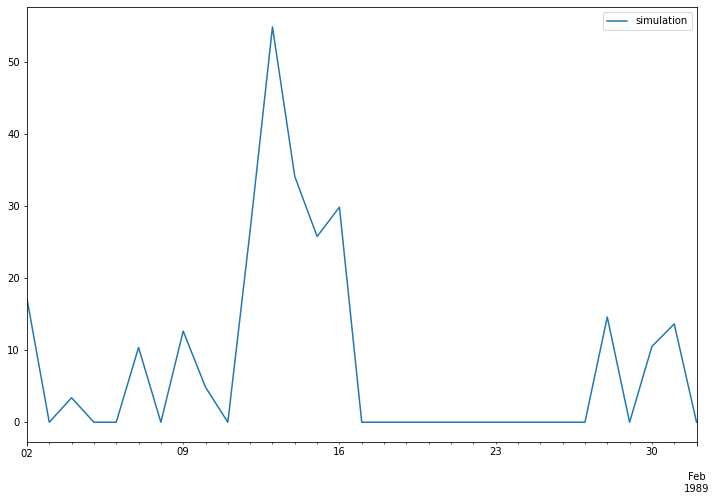
Running MARRMoT M14 model using eWaterCycle package
This notebooks shows how to run MARRMoT M14 model using an example use-case. More information about data, configuration and installation instructions can be found in the System setup in the eWaterCycle documentation.
1 In:
import warnings
warnings.filterwarnings("ignore", category=UserWarning)
1 In:
import pandas as pd
import ewatercycle.forcing
import ewatercycle.models
Load forcing data
To download the example forcing file BMI_testcase_m01_BuffaloRiver_TN_USA.mat, see this instruction.
2 In:
forcing = ewatercycle.forcing.load_foreign(
"marrmot",
directory=".",
start_time="1989-01-01T00:00:00Z",
end_time="1992-12-31T00:00:00Z",
forcing_info={"forcing_file": "BMI_testcase_m01_BuffaloRiver_TN_USA.mat"},
)
print(forcing)
eWaterCycle forcing
-------------------
start_time=1989-01-01T00:00:00Z
end_time=1992-12-31T00:00:00Z
directory=/home/sarah/GitHub/ewatercycle/docs/examples
shape=None
forcing_file=BMI_testcase_m01_BuffaloRiver_TN_USA.mat
Set up the model
To create the model object, we need to select a version.
3 In:
ewatercycle.models.MarrmotM14.available_versions
3 Out:
('2020.11',)
4 In:
model = ewatercycle.models.MarrmotM14(version="2020.11", forcing=forcing)
print(model)
The length of parameters in forcing /home/sarah/GitHub/ewatercycle/docs/examples/BMI_testcase_m01_BuffaloRiver_TN_USA.mat does not match the length of M14 parameters that is seven.
The length of initial stores in forcing /home/sarah/GitHub/ewatercycle/docs/examples/BMI_testcase_m01_BuffaloRiver_TN_USA.mat does not match the length of M14 iniatial stores that is two.
eWaterCycle MarrmotM14
-------------------
Version = 2020.11
Parameter set =
None
Forcing =
eWaterCycle forcing
-------------------
start_time=1989-01-01T00:00:00Z
end_time=1992-12-31T00:00:00Z
directory=/home/sarah/GitHub/ewatercycle/docs/examples
shape=None
forcing_file=BMI_testcase_m01_BuffaloRiver_TN_USA.mat
5 In:
model.parameters
5 Out:
[('maximum_soil_moisture_storage', 1000.0),
('threshold_flow_generation_evap_change', 0.5),
('leakage_saturated_zone_flow_coefficient', 0.5),
('zero_deficit_base_flow_speed', 100.0),
('baseflow_coefficient', 0.5),
('gamma_distribution_chi_parameter', 4.25),
('gamma_distribution_phi_parameter', 2.5),
('initial_upper_zone_storage', 900.0),
('initial_saturated_zone_storage', 900.0),
('solver',
Solver(name='createOdeApprox_IE', resnorm_tolerance=array([0.1]), resnorm_maxiter=array([6.]))),
('start time', '1989-01-01T00:00:00Z'),
('end time', '1992-12-31T00:00:00Z')]
Setup model with maximum soil moisture storage of 12.0 instead of 10.0 and an earlier end time, making total model time just 1 month.
6 In:
cfg_file, cfg_dir = model.setup(
maximum_soil_moisture_storage=12.0,
end_time="1989-02-01T00:00:00Z",
)
print(cfg_file)
print(cfg_dir)
/home/sarah/GitHub/ewatercycle/docs/examples/marrmot_20210712_135152/marrmot-m14_config.mat
/home/sarah/GitHub/ewatercycle/docs/examples/marrmot_20210712_135152
7 In:
model.parameters
7 Out:
[('maximum_soil_moisture_storage', 12.0),
('threshold_flow_generation_evap_change', 0.5),
('leakage_saturated_zone_flow_coefficient', 0.5),
('zero_deficit_base_flow_speed', 100.0),
('baseflow_coefficient', 0.5),
('gamma_distribution_chi_parameter', 4.25),
('gamma_distribution_phi_parameter', 2.5),
('initial_upper_zone_storage', 900.0),
('initial_saturated_zone_storage', 900.0),
('solver',
Solver(name='createOdeApprox_IE', resnorm_tolerance=array([0.1]), resnorm_maxiter=array([6.]))),
('start time', '1989-01-01T00:00:00Z'),
('end time', '1989-02-01T00:00:00Z')]
Initialize the model with the config file:
8 In:
model.initialize(cfg_file)
Get model variable names, only flux_out_Q is supported for now.
9 In:
model.output_var_names
9 Out:
('P',
'T',
'Ep',
'S(t)',
'par',
'sol_resnorm_tolerance',
'sol_resnorm_maxiter',
'flux_out_Q',
'flux_out_Ea',
'wb')
Run the model
10 In:
discharge = []
time_range = []
end_time = model.end_time
while model.time < end_time:
model.update()
discharge.append(model.get_value("flux_out_Q")[0])
time_range.append(model.time_as_datetime.date())
print(model.time_as_isostr)
1989-01-02T00:00:00Z
1989-01-03T00:00:00Z
1989-01-04T00:00:00Z
1989-01-05T00:00:00Z
1989-01-06T00:00:00Z
1989-01-07T00:00:00Z
1989-01-08T00:00:00Z
1989-01-09T00:00:00Z
1989-01-10T00:00:00Z
1989-01-11T00:00:00Z
1989-01-12T00:00:00Z
1989-01-13T00:00:00Z
1989-01-14T00:00:00Z
1989-01-15T00:00:00Z
1989-01-16T00:00:00Z
1989-01-17T00:00:00Z
1989-01-18T00:00:00Z
1989-01-19T00:00:00Z
1989-01-20T00:00:00Z
1989-01-21T00:00:00Z
1989-01-22T00:00:00Z
1989-01-23T00:00:00Z
1989-01-24T00:00:00Z
1989-01-25T00:00:00Z
1989-01-26T00:00:00Z
1989-01-27T00:00:00Z
1989-01-28T00:00:00Z
1989-01-29T00:00:00Z
1989-01-30T00:00:00Z
1989-01-31T00:00:00Z
1989-02-01T00:00:00Z
11 In:
model.finalize()
Inspect the results
12 In:
simulated_discharge = pd.DataFrame(
{"simulation": discharge}, index=pd.to_datetime(time_range)
)
13 In:
simulated_discharge.plot(figsize=(12, 8))
13 Out:
<AxesSubplot:>
